We visited two plazas, the cathedral and a church on this day. I will describe the cathedral with one word: huge. And the second plaza with one word: captivating.
And we’re off. . . to the first plaza: Plaza del Cabildo. It was small and pretty. It would be a nice place to stop for a break if one was needed. (We will share pictures from the other plaza in the next post.)


La Catedral de Santa María (also called La Catedral de Sevilla)
La Catedral de Sevilla, in addition to being the largest Gothic temple in Europe and the world’s third-largest church, is an excellent example of Gothic and Renaissance architecture and represents some seven centuries of history. Its architecture is both beautiful and grand. It has four huge façades that combine to form 15 majestic doors. Since the cathedral was built in a Gothic architectural style, all the doors are beautifully ornamented. The decorations display different scenes from the life of Jesus. The major doors are the Door of Baptism, Assumption, Saint Michael, Saint Cristopher, Sticks, Bells, Conception, Lizard, Sanctuary, Forgiveness, Prince, Saint Miguel, and Palos.
Seville Cathedral was registered as a UNESCO World Heritage Site in 1987.
The Cathedral was originally the site of a large mosque that was built in the 12th century when the Almohad empire ruled not only Sevilla but most of Spain. After Spanish Christians under Ferdinand III gained possession of Sevilla in 1248, the mosque was almost entirely destroyed. All that remains of the original mosque is the Patio de los Naranjos (Orange Tree Courtyard) entrance court, where Muslim faithful once washed their hands and feet in the fountain before entering the mosque, and a minaret that was built between 1184 and 1196.
As Sevilla grew in importance, the Spanish decided that they wanted to build a church on a suitably grand scale to reflect the city’s position as an affluent trading center. Construction of the cathedral began in 1403 on the rectangular foundations of the mosque, and was completed in 1506 (some sources say 1507). When the cathedral was built, a bell was added to the one time minaret together with the Christian symbol of the cross, transforming it into a bell tower called the Giralda. The bell tower was finished in 1568 with the addition of an 11-foot-high weather vane of a woman, representing the Christian faith, that was cast by Bartolomé Morel. The tower is 343 feet (104.5 meters) tall and is one of the most important symbols of Seville since medieval times.
Inside, the cathedral is impressive both for its artworks in the form of paintings, sculptures, and wood carvings, and for its architectural mix of Gothic, Renaissance, Baroque, and Plateresque styles. Additionally, the cathedral houses the tomb of explorer Christopher Columbus. Columbus’ tomb is held up by allegorical figures representing Spain’s four kingdoms. Sculpted by Arturo Melida in 1899, the tomb was originally in Havana until Spain lost control of Cuba. Columbus’ remains were moved several times before arriving back in Seville. Other famous people who have been buried in a few of the chapels include:
— Fernando III of Castile
— Elisabeth of Hohenstaufen
— Alfonso X of Castile
— Ferdinand Columbus
— María Díaz de Padilla
Fun Facts:
— Total area of Cathedral: 37,795 square feet (11,520 square meters)
— Length: 443 feet (135 meters)
— Width: 249 feet (76 meters)
— Maximum height in transept: 138 feet (42 meters)
— The main dome collapsed twice, once in 1511 and again in 1888, both times restored to its former glory
— The Cathedral is home to 80 different chapels, including the Royal Chapel (Capilla Real)
— A total of 500 masses were conducted daily in all the chapels in the 19th century
I borrowed these exterior pictures since it was impossible for me to capture the huge structure.



Here are the exterior pictures I took. They provide some closer looks at the building.

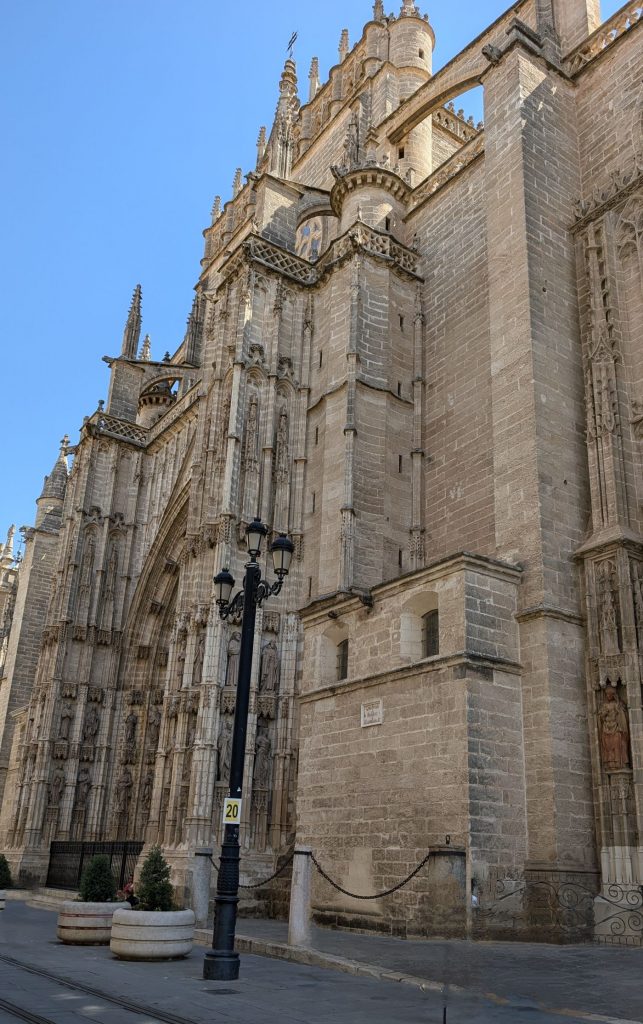


You can see the top of the Door of the Prince (just the ornamentation, not the full door) in the following pictures.
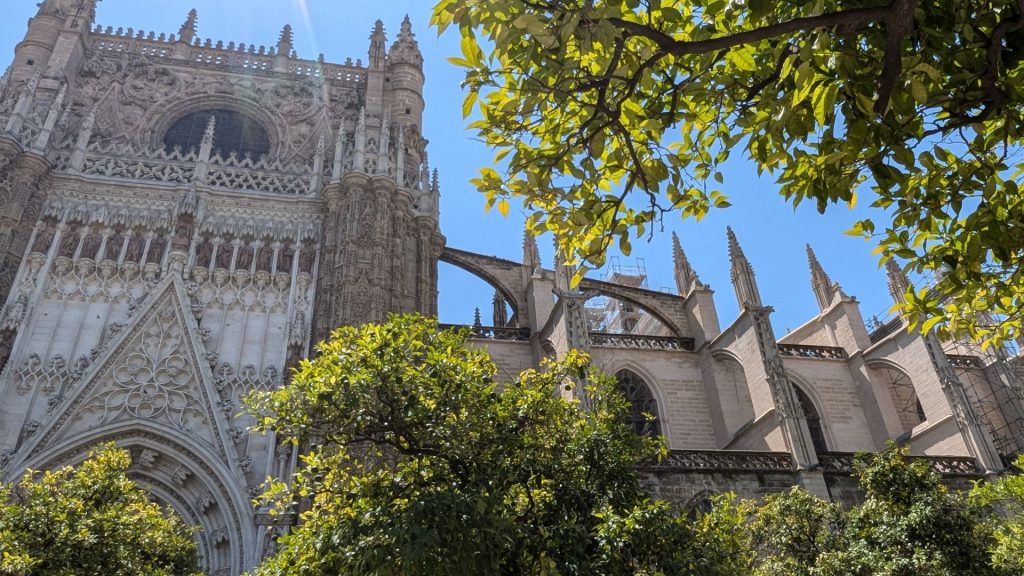


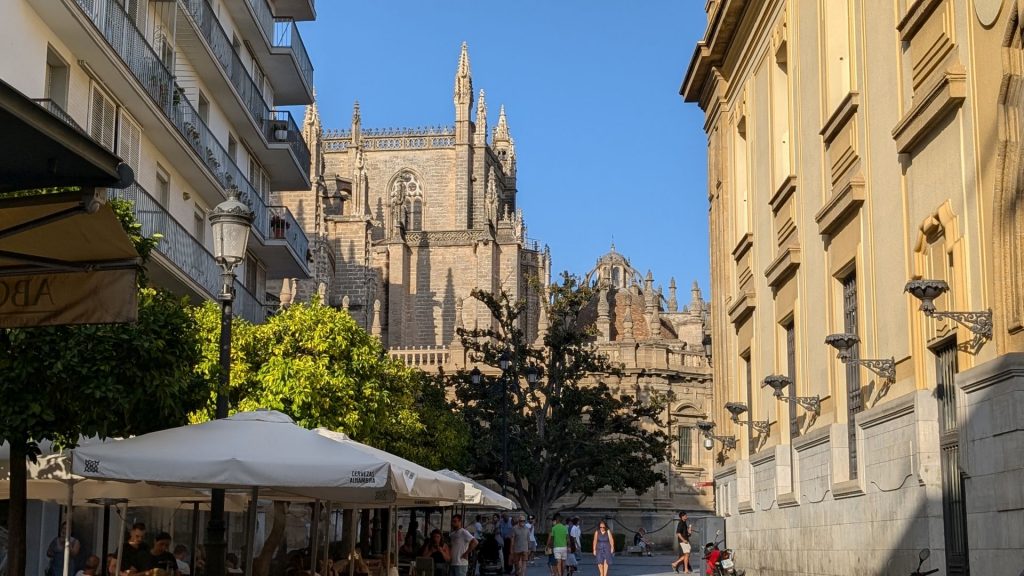
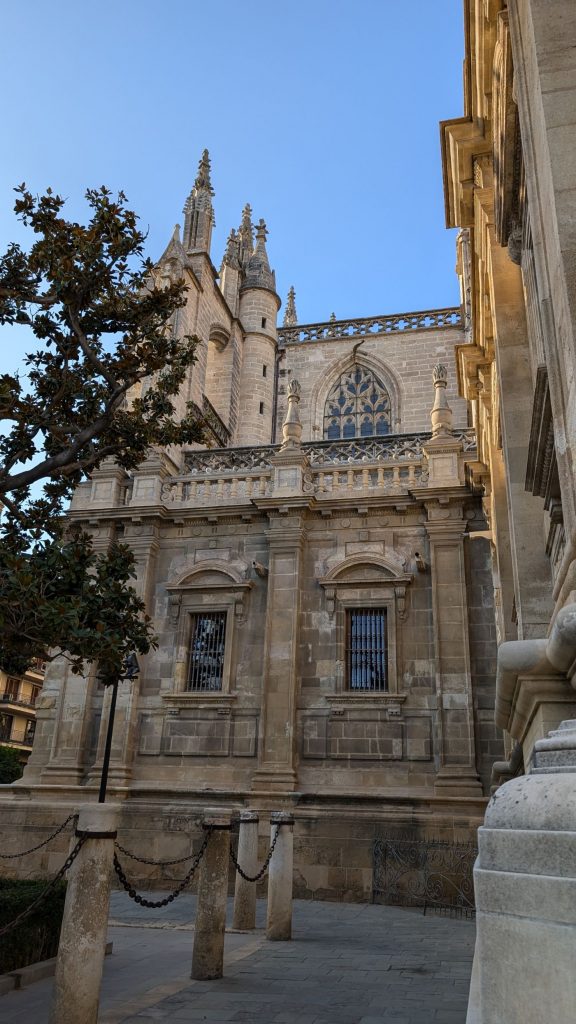
That’s it for the exterior.
As noted above, there are 80 chapels. Now, let me say that even though I thought there were a heck of a lot of chapels, I would never have guessed that there are 80! Don’t worry, I won’t share pictures of 80 chapels with you. I picked the ones that grabbed me the most. Sometimes it was the sheer quantity of gold and ornamentation that captured my attention, other times it was the image(s) that intrigued me and made me want to learn more about, and often it was the incredible amount of detail in the display. As for the artwork, interesting stories always entertain me.
Let’s start with a couple of paintings. The first one is Abraham and the Three Angels. Artist: Abraham van Diepenbeeck, Dutch painter, ca. 1650. This is located in the Chapel of Saint Anne.

The next one, Justa and Rufina, is located in the Chapel of Santa Barbara. Artist: Miguel de Esquivel, ca. first quarter of the 17th century. These two saints supposedly protected the tower during the earthquake of 1504 and that prevented it from collapsing.
Beyond their connection to the cathedral, there is a legend about these two sisters. They were natives of Seville who are said to have lived in the neighborhood of Triana. They made fine earthenware pottery for a living, with which they supported themselves and helped many of the city’s poor. Like many other merchants, they sold their pottery from booths set up out of doors where people could see their wares. During a pagan festival, they refused to sell their wares for use in these celebrations. In anger, locals broke all of their dishes and pots. Justa and Rufina retaliated by smashing an image of Venus. They were immediately arrested. The story gets pretty gross now. Suffice it to say that they are considered martyrs.
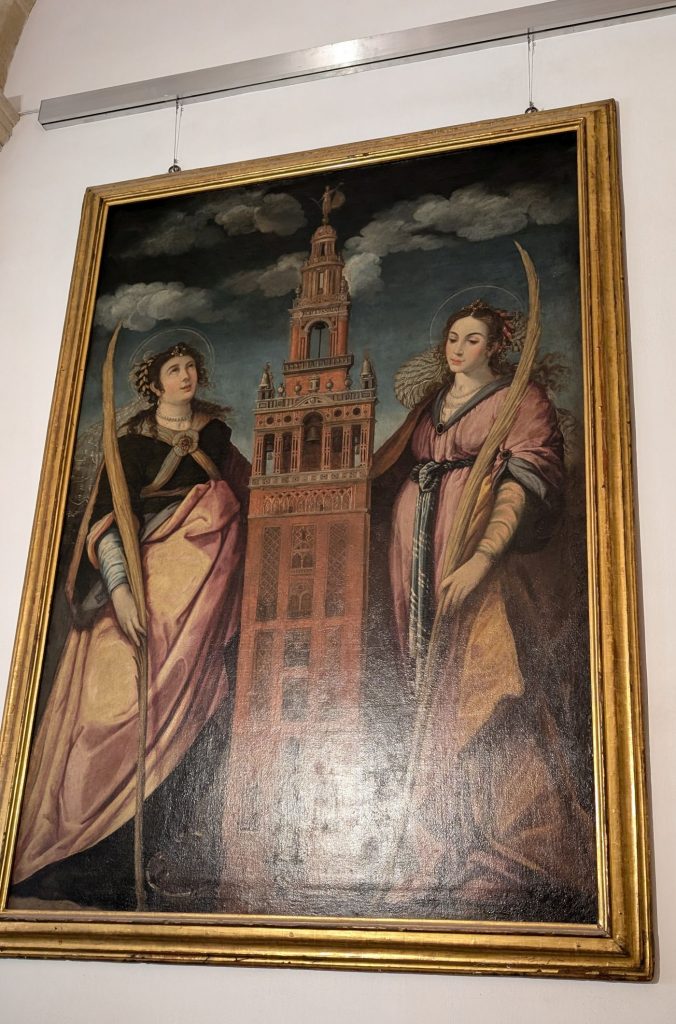
Below is the sepulcher of Cardinal Sir Juan de Cervantes, built in alabaster by Lorenzo Mercadante de Bretaña between 1453 and 1458.

Left hand side below: same sepulcher as above. The stained-glass window is by Francisco Gutiérrez (1819).
Right hand side below: to the left of the sepulcher is this altarpiece by Manuel Garcia Santiago (1752). The altarpiece is dominated by a sculpture of San Hermenegildo by Bartolomé García de Santiago (half 18th century). I found the altarpiece to be particularly ornamental.


The next four photos are dedicated to the Virgin of Antigua Chapel. The first three pictures show the left, center and right side of the chapel. The fourth is a close up of the altar.
Story: In 1500, Cardinal Diego Hurtado de Mendoza ordered the original chapel to be enlarged for burial, since the great devotion that the Virgin of Antigua had among the Sevillians well deserved the largest chapel of those considered minor chapels. The fresco of the Virgin of Antigua presides over the marble altarpiece by José Fernández de Iglesias with sculptures by Pedro Duque Cornejo (half 18th century). This Virgin dates from the time when the mosque was used as a Christian temple (14th century). The goldsmith’s crown was added in 1929 for her canonical coronation. The paintings, which iconographically represent the history of the Virgin of Antigua, as well as the saints and some landscapes, are works by Domingo Martínez (first half of the 18th century). Also noteworthy are the tombs of Cardinal Diego Hurtado de Mendoza, in Renaissance style, made by Doménico Fancelli (early 16th century) and that of Archbishop Luis Salcedo y Azcona, made by Pedro Duque Cornejo (mid 18th century) and inspired by the Renaissance one. Stained glass windows: San Fernando, designed by José Gestoso (19th century).

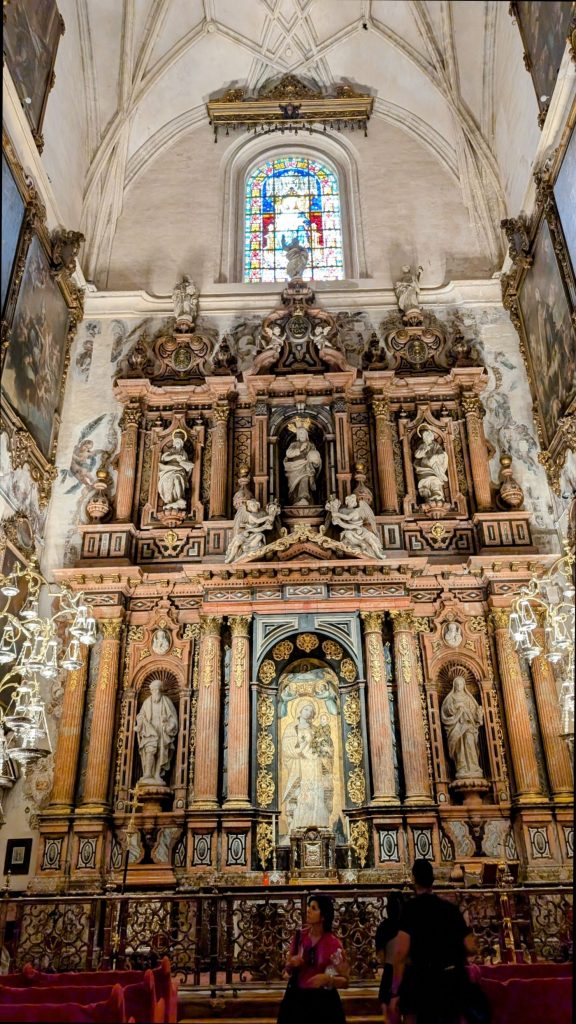
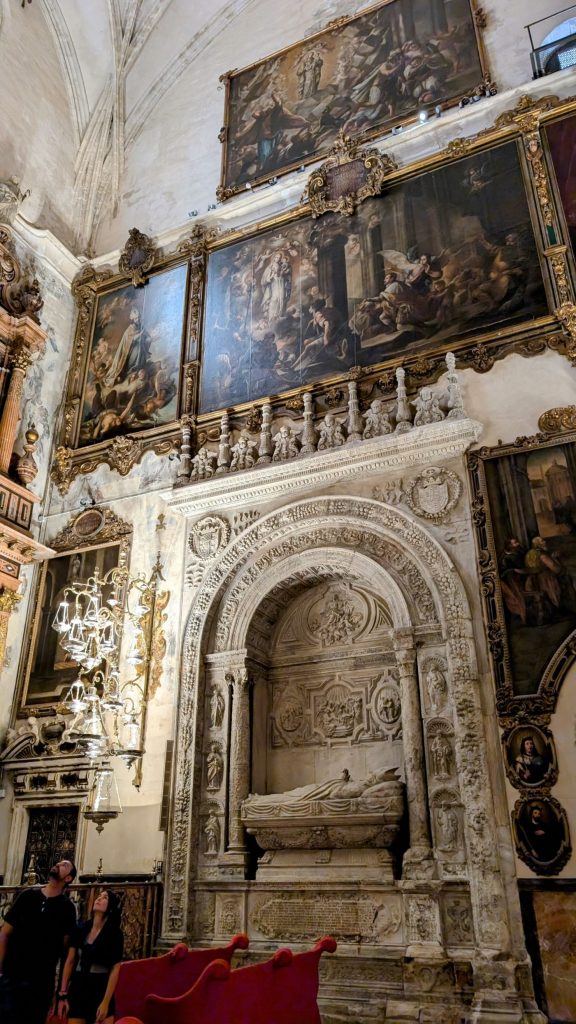
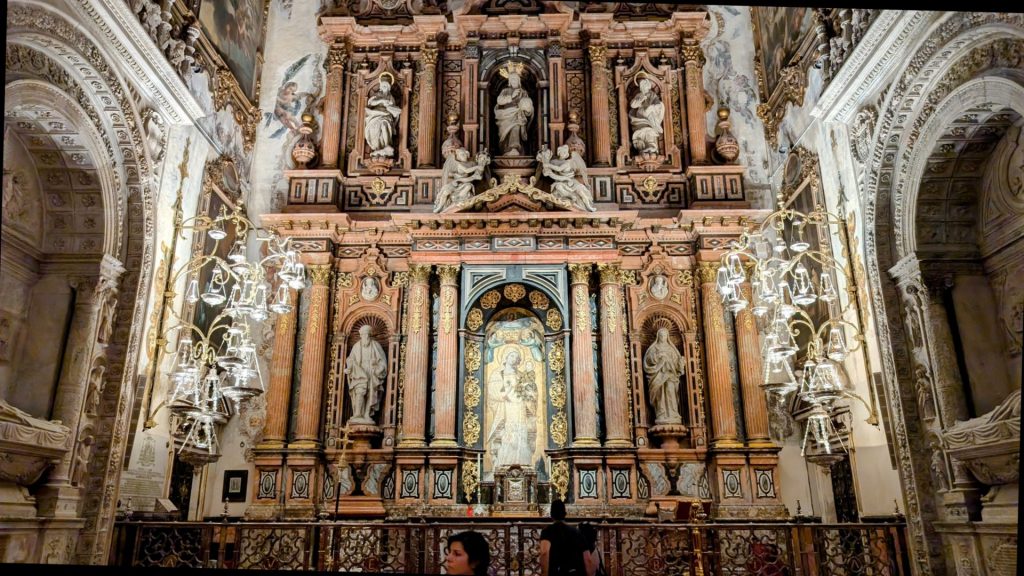
Organ
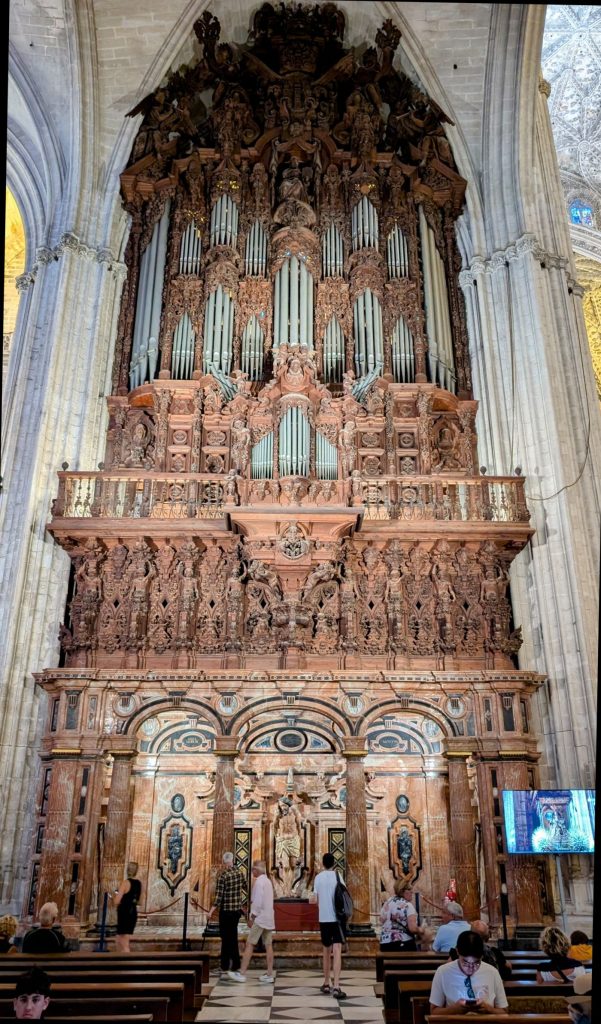
The Immaculate Conception by Juan Martínez Montañés known as “La Cieguecita,” is a sculpture dated between 1629 and 1631, which is preserved in the chapel of the Immaculate Conception. Since the Middle Ages, Seville has defended the belief that the Virgin Mary was born without the stain of Original Sin.
My interest was piqued because of the figures beneath her robe. This is what the plaque said: “A great sign appeared in heaven: a woman clothed with the sun, and the moon under her feet, and a crown of twelve stars on her head. With these words from the book of Revelation, the artists configured their representations of this theme. She is popularly called The Little Blind Lady, since with her lowered gaze she tries to connect visually and spiritually with the one who prays to her.”

As noted above, the cathedral houses the tomb of explorer Christopher Columbus. Columbus’ tomb is held up by allegorical figures representing Spain’s four kingdoms.
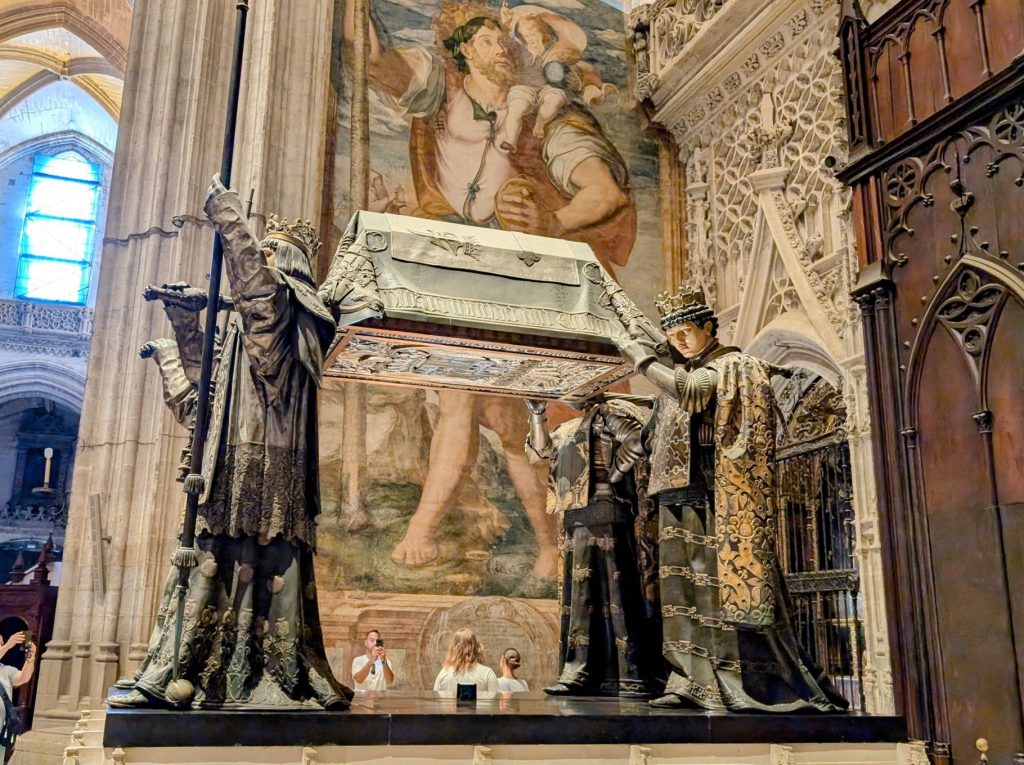


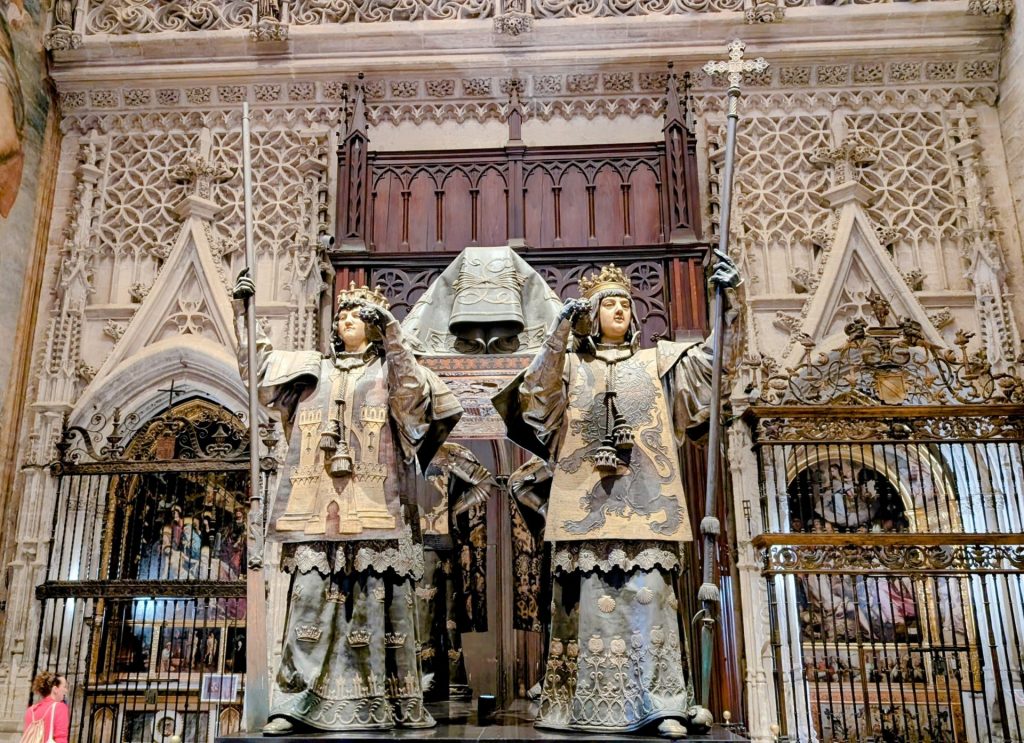

Attached to the south side of the cathedral, the Sacristía Mayor, or Great Sacristy, is a Renaissance-style cross-shaped building crowned by a circular dome at the crossing. Surmounting the dome is a beautiful roof lantern built to provide daylight to the hall below. The work on this building was started by the Spanish architect Diego de Riaño, and after he died in 1534, Martin de Gainza continued the work and completed it in 1543.
Preserved in the sacristy are the art treasures that provide a glimpse of the glorious era when religious art flourished in Seville. On display are finely crafted liturgical items, including monstrances, reliquaries, custodias, and crosses, mostly made of precious metals like gold and silver. Adorning the walls of the sacristy are the masterpieces painted by famous painters, including Goya, Murillo, Campaña, and Zurbarán.
All of the pictures I will share next are of this room. I will let you know when we leave the room. It was my favorite room in the cathedral.
Located in the center of the room is the Custodia de Arfe (pictured below), a processional custodia made by Juan de Arfe y Villafañe, a master sculptor born into a prominent family of goldsmiths/silversmiths.
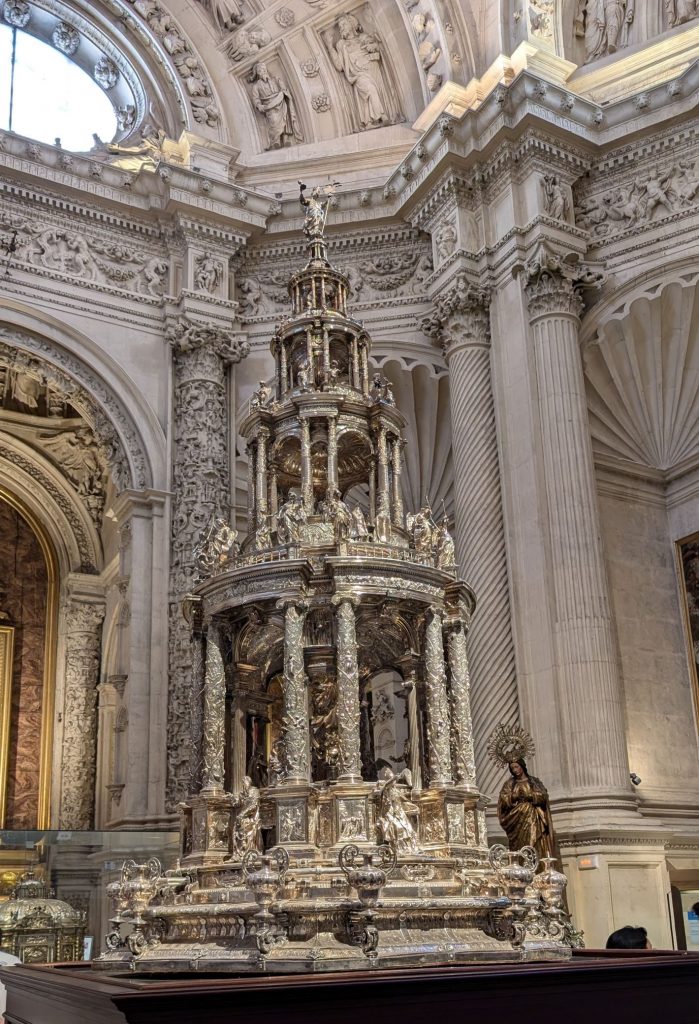
Pictured below on the left is an ornate wall with a painting titled The Descent. 1547. Painter: Pedro de Campana. A close up of the painting is on the right.

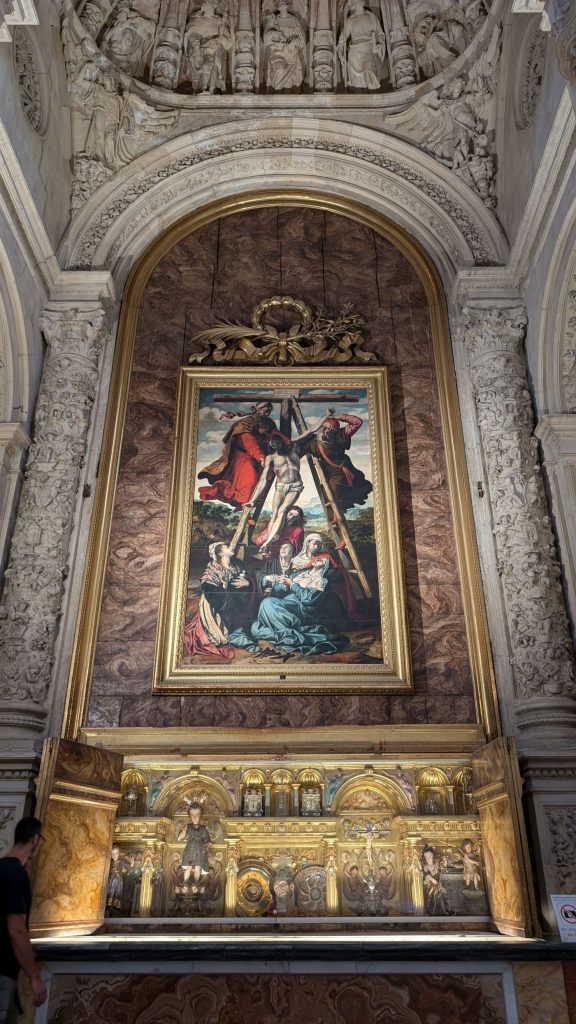
Pictured below on another ornate wall, is a painting of Saint Leander of Seville. 1655. Painter: Bartolome Esteban Murillo. Again, a closeup of the painting is on the right.

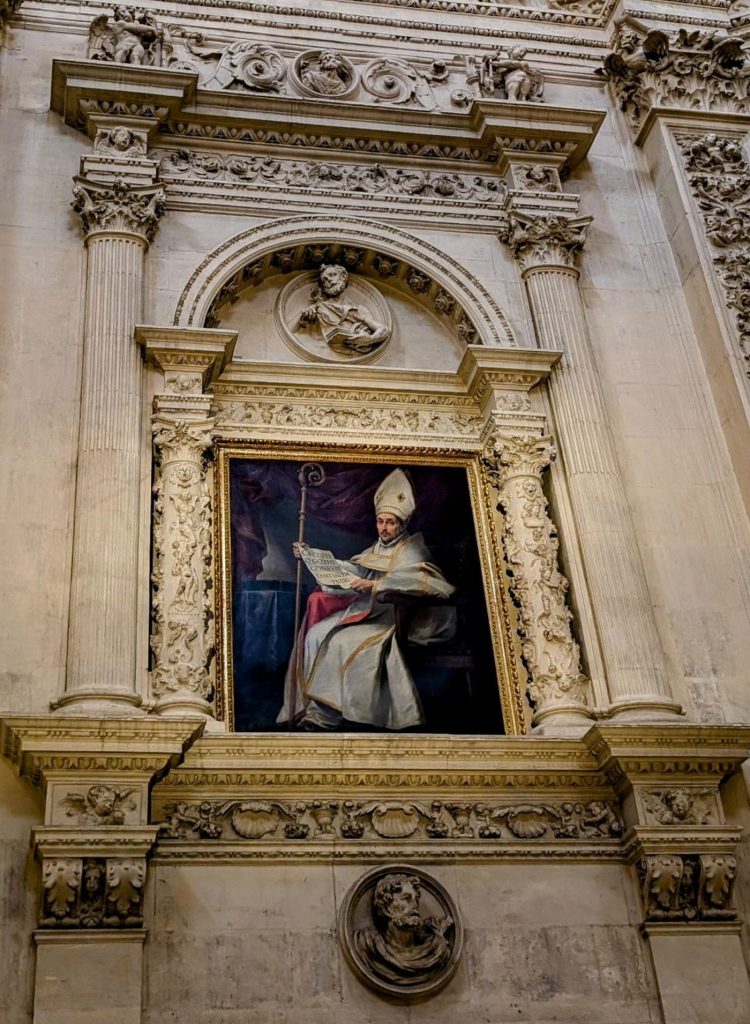
Using the same picture/closeup M.O. pictured below is Saint Isidore of Seville. 1654. Painter: Bartolome Esteban Murillo.


Below is a picture of the Sculpture of King Ferdinand III of Castile or Saint Ferdinand. 1671. Sculptor: Pedro Roldan.

And perhaps my favorite picture: the domed ceiling. They even put a mirror on the floor tilted up to help with pictures. There was a line and I stood in it.

This is actually one time I wish I’d taken more pictures. This room contains so much more than I shared.
Chapel of the Conception
This magnificent Baroque altarpiece from the 17th century is decorated with Solomonic columns and was made by Martín Moreno (1656-1658) and the images by Alonso Martínez (1656-1658), with the exception of the Crucified Saint Paul. It includes Immaculate Maria, Saint José, Saint Pablo, Saint Gonzalo, and Saint Antonio. The Crucifix is attributed to Jorge Fernández Alemán (c. 1520).
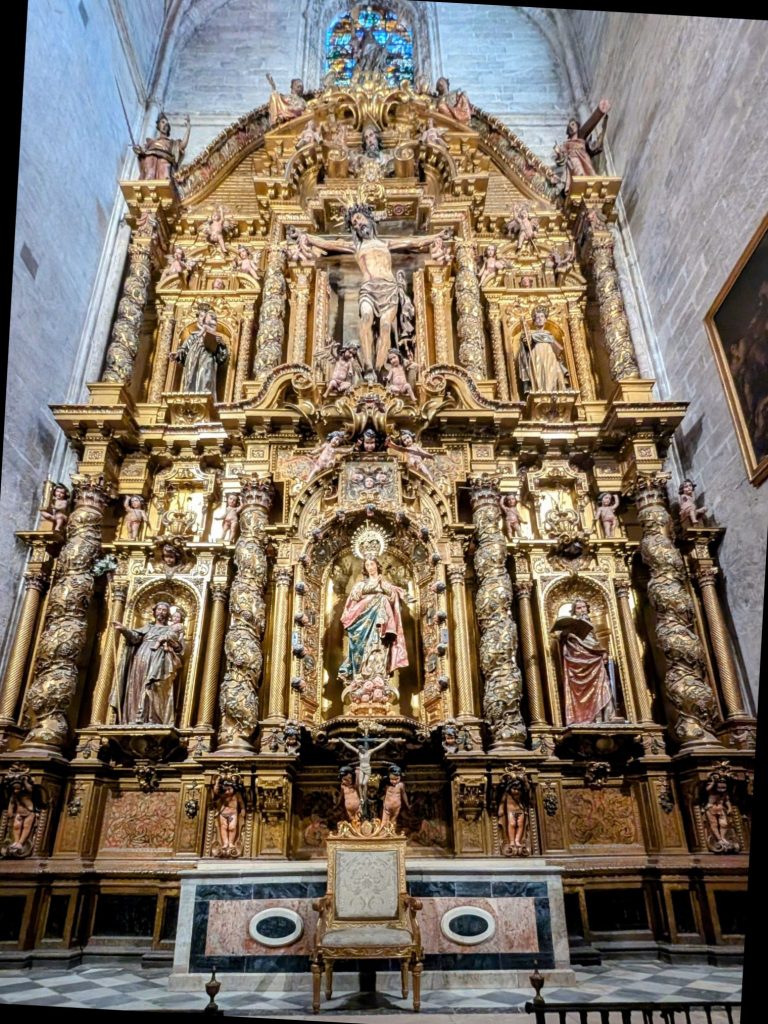
Silver Altar
The Silver Altar is a shining example (pun intended) of the mastery of Sevillian craftsmen. It owes its name to the abundant use of silver in the altar. That is also what attracted my attention!
In the center of the altar is a statue of the Virgin Mary with the Child Jesus flanked by sculptures of San Isidoro and San Leandro. Behind it is the large and exquisitely-crafted silver monstrance shaped like the sun. Mounted on top of the monstrance is a crown. Mounted on the wall just above the silver altar is a beautiful painting depicting the Ascension of the Virgin Mary. Above this painting is a circular stained-glass window depicting the Ascension of Jesus made by Carlos de Brujas in 1588.
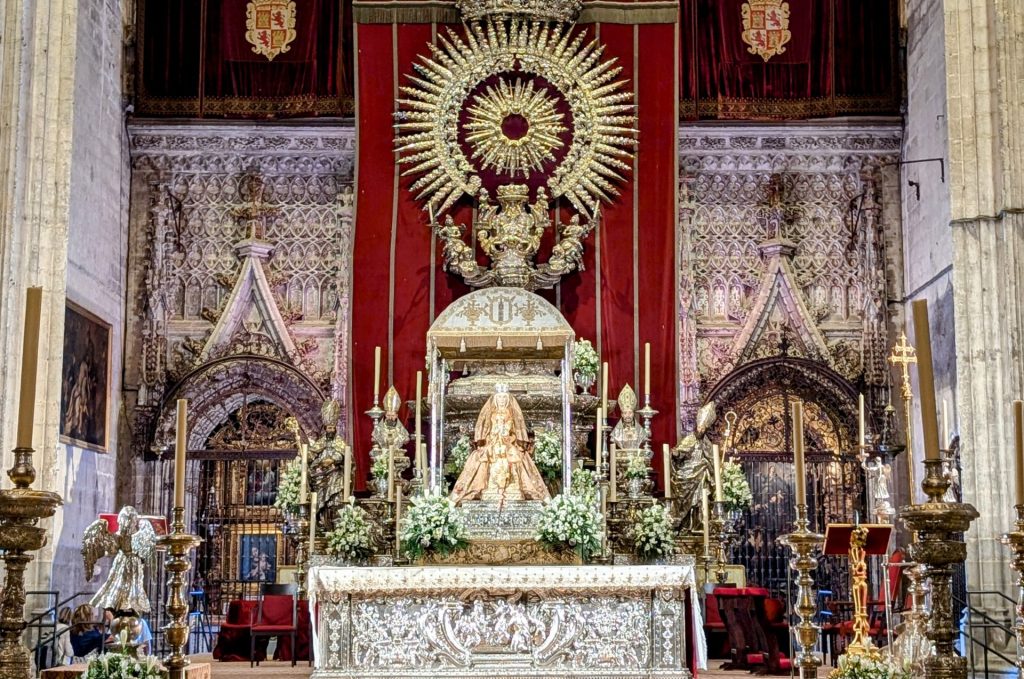
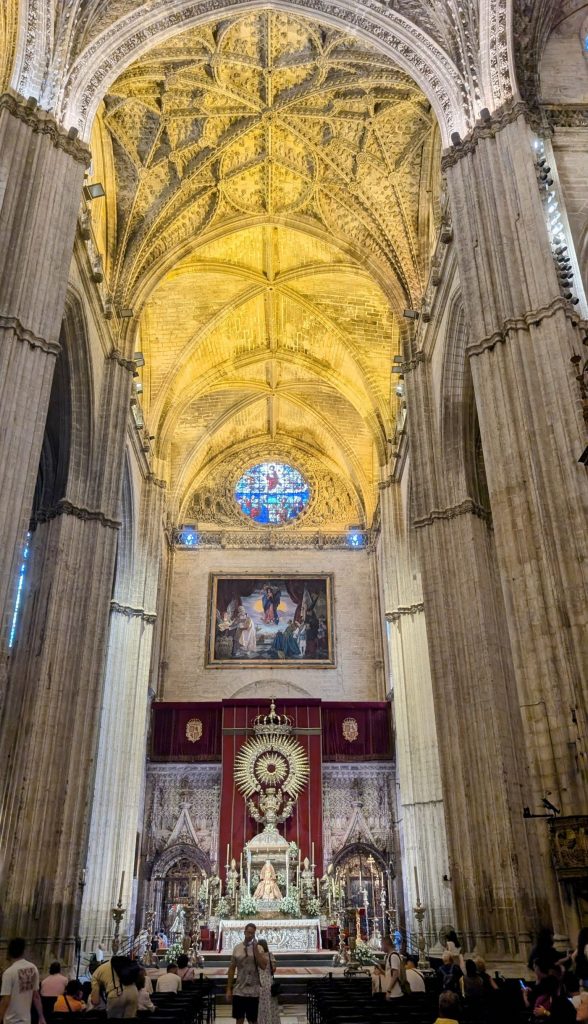

The Retablo Mayor, the largest altarpiece in the world, consists of thirty-six gilded relief panels depicting scenes from the Old Testament and the lives of saints. At the altar in front of the wall of gold sits a statue of Santa Maria de la Sede, the patron saint of the Cathedral.
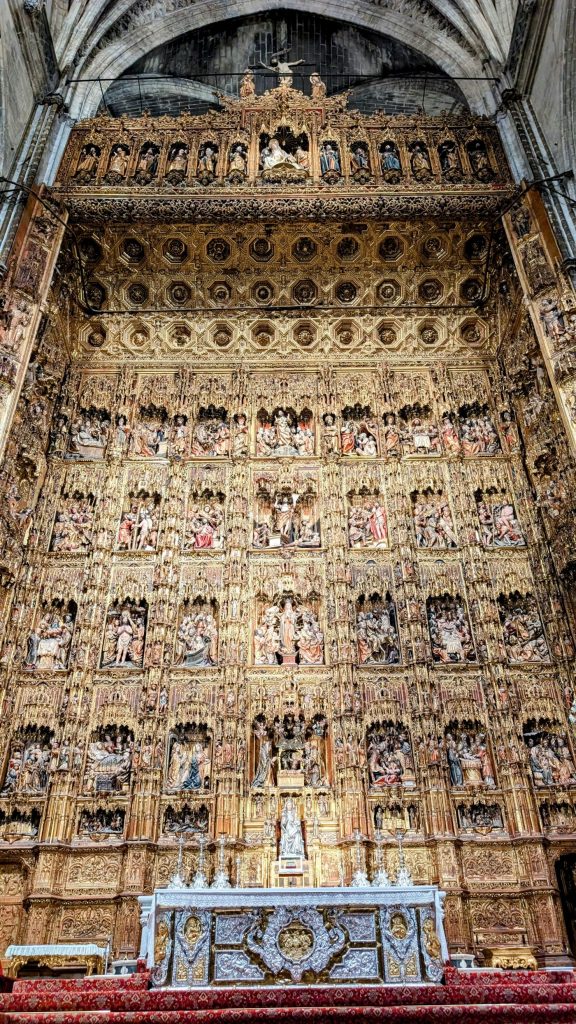


The Choir is a fundamental place in the spatial and functional conception of a Cathedral. At this cathedral, the seats, made of different types of wood and where several authors took part, are from the beginning of the 16th century and have a magnificent sculptural and iconographic program. It should be noted that the 117 seat backs have completely different decorations, made with inlays based on Mudejar lacework. This type of Mudejar adornment in the Choir is only found in the Cathedral of Puebla in Mexico, where the influence of the Cathedral of Seville in New Spain is again evident.
In the center, a large Renaissance lectern, carved in wood, which was used to place the huge liturgical chant books. Dating from the second half of the 16th century, it was made, among others, by Juan Bautista Vázquez “the Old”, who also masterfully carved the Virgin with Child, who presides over the lectern.

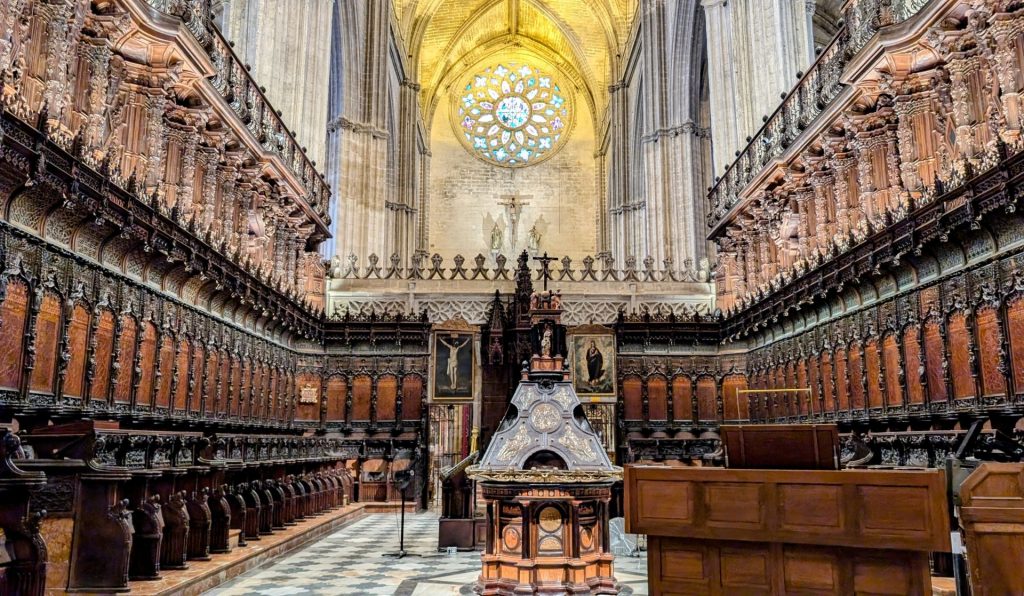
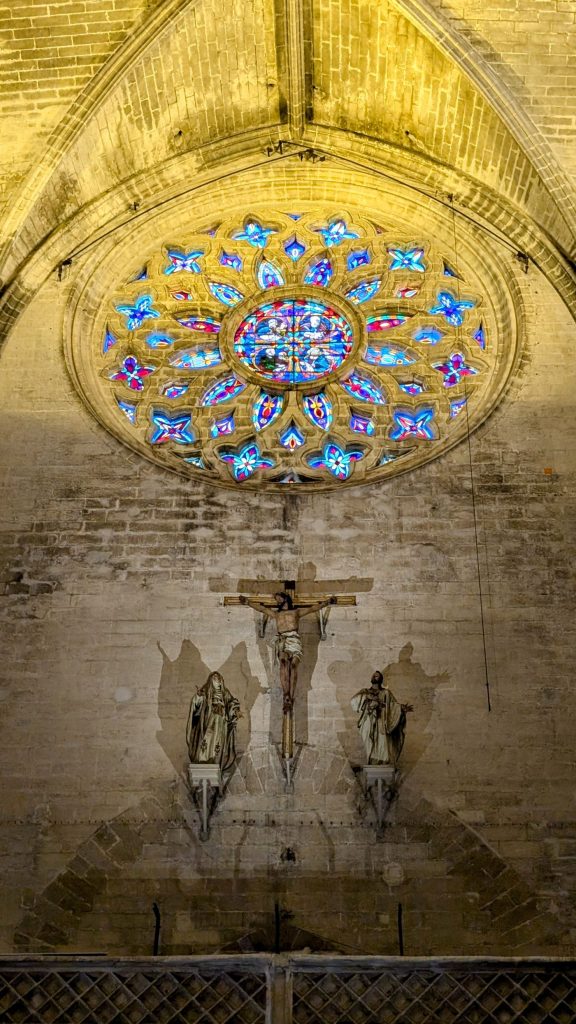
In the “Constitution on the Sacred Liturgy,” during the Second Vatican Council, it is ruled that “the pipe organ be held in great esteem, … whose sound can bring remarkable splendor to ecclesiastical ceremonies and powerfully lift souls towards God and to heavenly realities.” I would say that the cathedral nailed it!
The organ of the Cathedral of Seville is made up of two instruments located in two pieces of furniture (18th century) and that sound from a single console, made up of four keyboards and one pedalboard (from 1901-1903). The left organ was destroyed in 1888 by an earthquake, after which the organ builder Aquilino Amezua rebuilt it. And a novel electrical connection was made in 1973.


The retrochoir is located behind the choir. It is one of my favorite parts of the cathedral. The retrochoir was built by Miguel de Zumárraga in the 17th century. Above the retrochoir you can see the magnificent ceiling above the choir and the main chapel. At the center is a beautiful painting depicting the Virgin of the Remedies. (The Virgin of the Remedies is one of numerous titles of the Virgin Mary.)




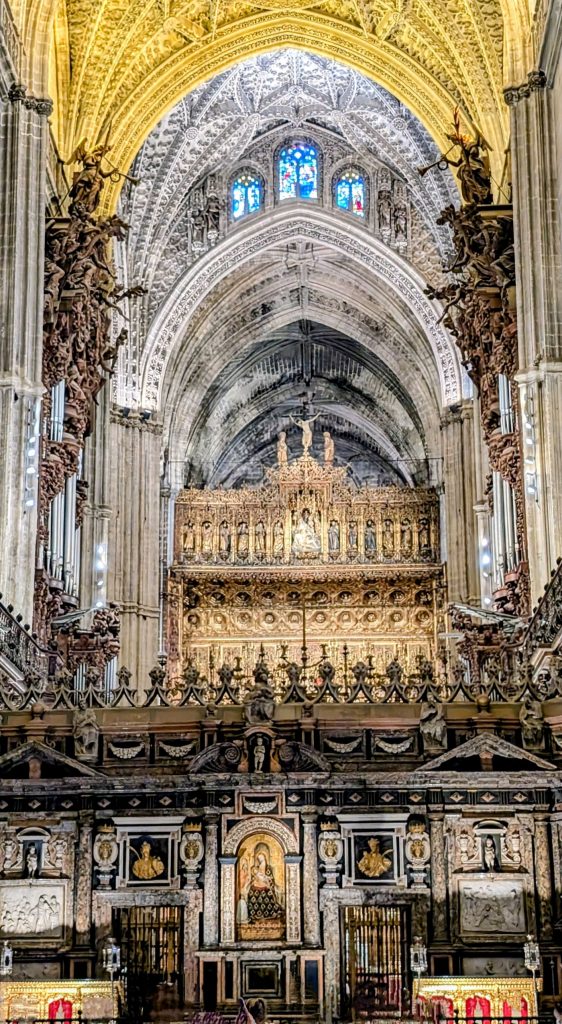
Here are a few more pictures. I assume you are tired of reading about each of them, so I will primarily just post pictures, and sometimes include captions.
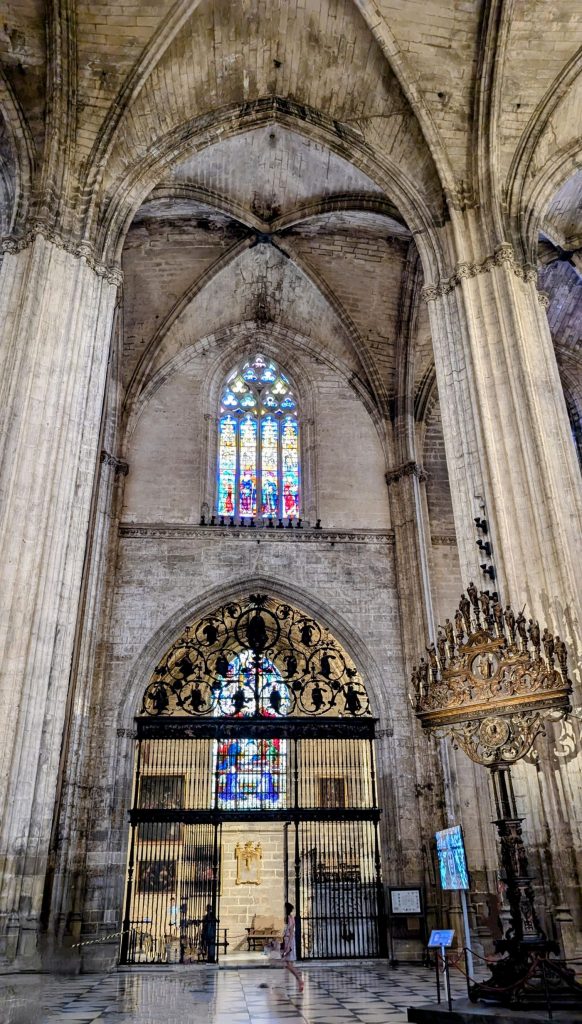
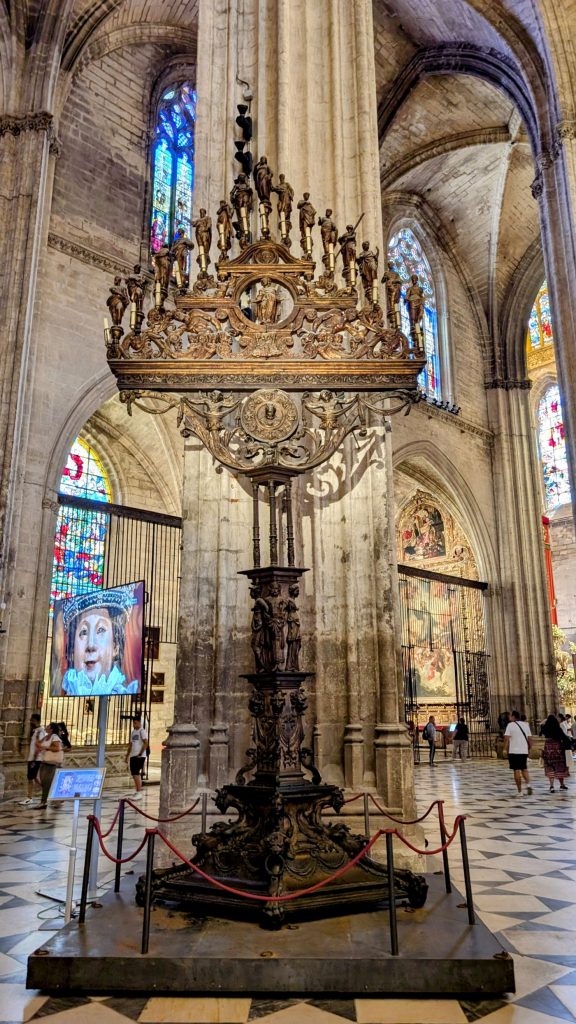
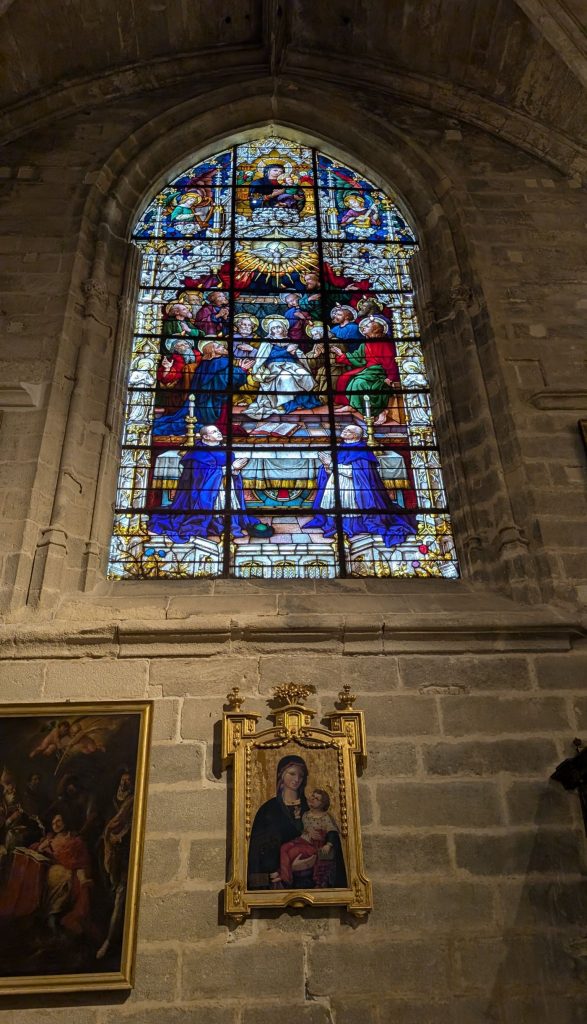




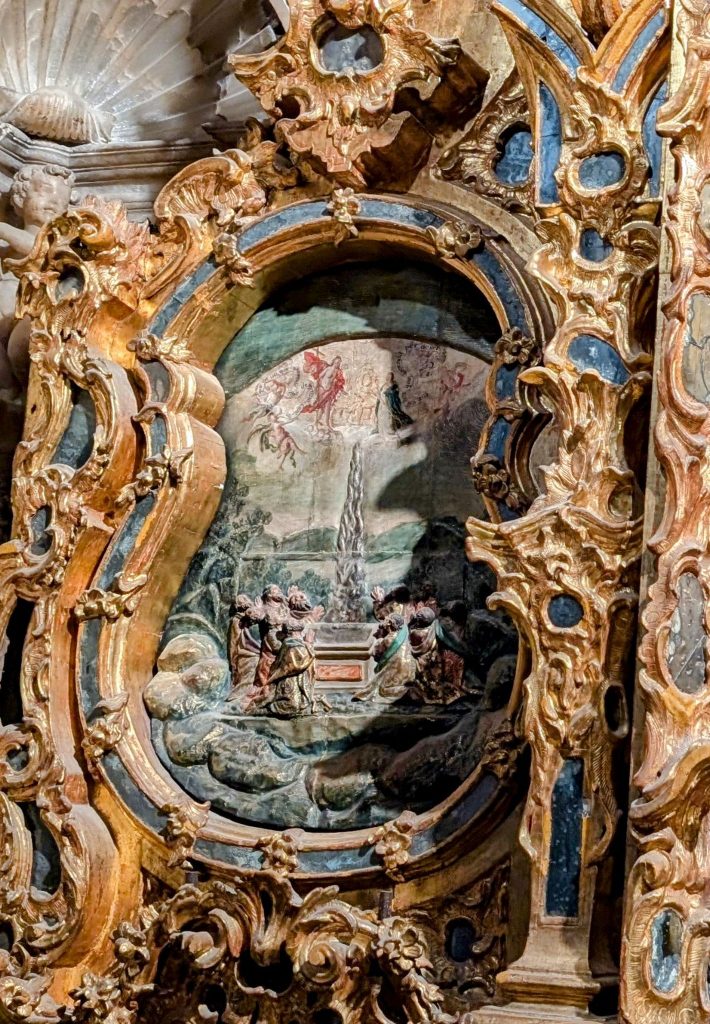
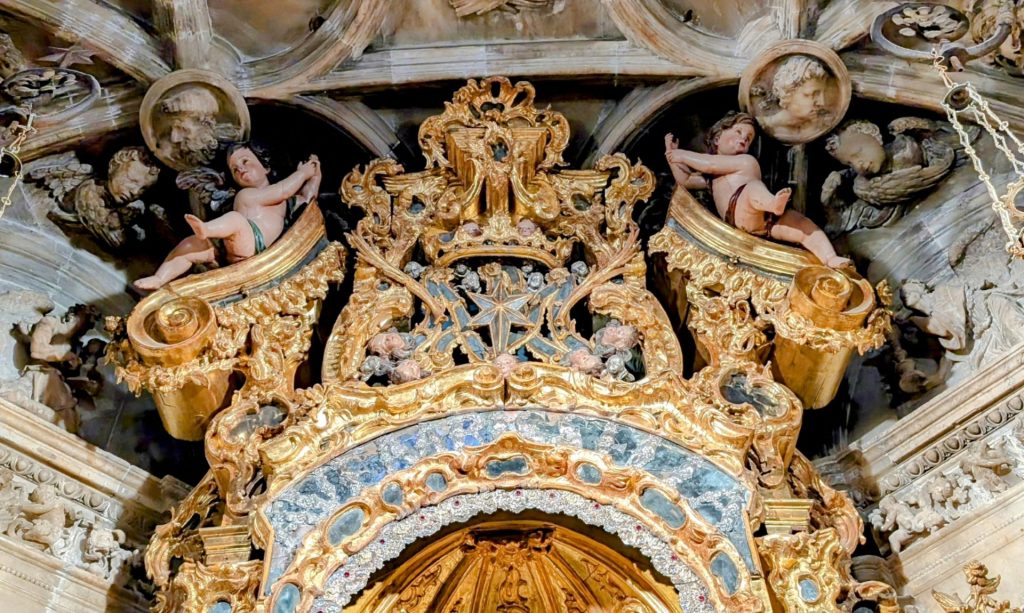

The following altarpiece is one of the oldest preserved in the cathedral. Shows the most revered saints in Seville with the Virgin and Child Jesus at the top, with the crucifixion in the center.
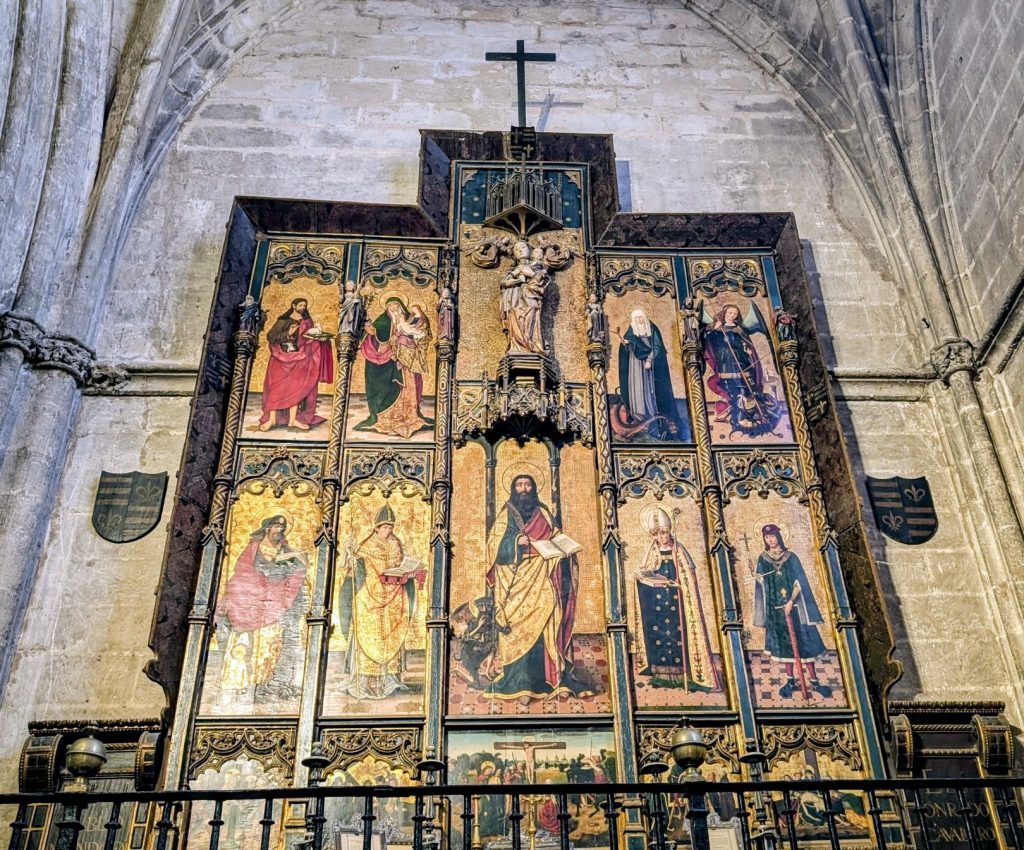



The second religious structure we visited was the “Iglesia Colegial del Divino Salvador,” or the Church of the Divine Savior. It is, after the Cathedral of Seville, the most important church in Seville. The church was built on a site where a basilica stood in Roman times and a mosque during the Moorish period. After the conquest of Seville by Castile in 1248, the mosque was converted into a church and named San Salvador (‘Holy Savior’). The building did not undergo any major changes until 1669, when archbishop Payno Osorio visited it. He found it in dangerously neglected condition and decided to condemn the building and order its demolition. Construction on a new church began in 1674 and was finished in 1712, resulting in the lofty Baroque edifice overlooking Plaza del Salvador today.
If you want to use one word to describe the interior, just go with “gold.”
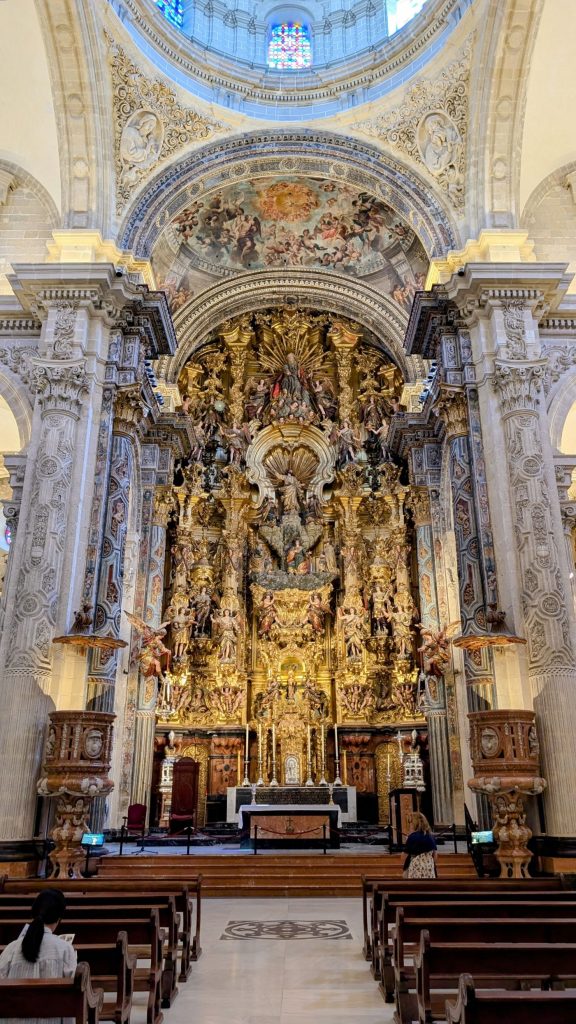
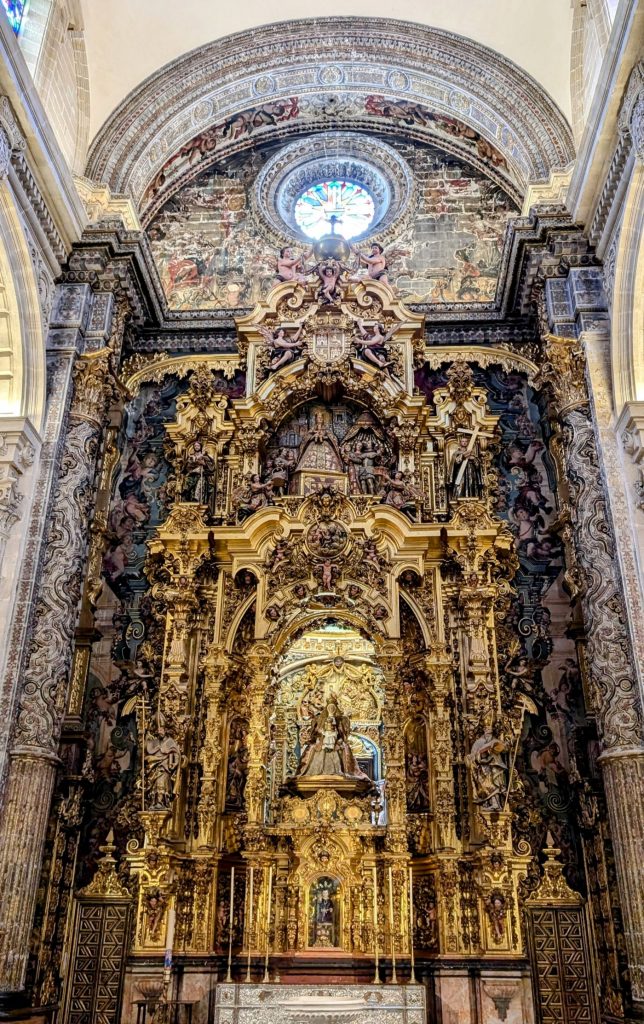
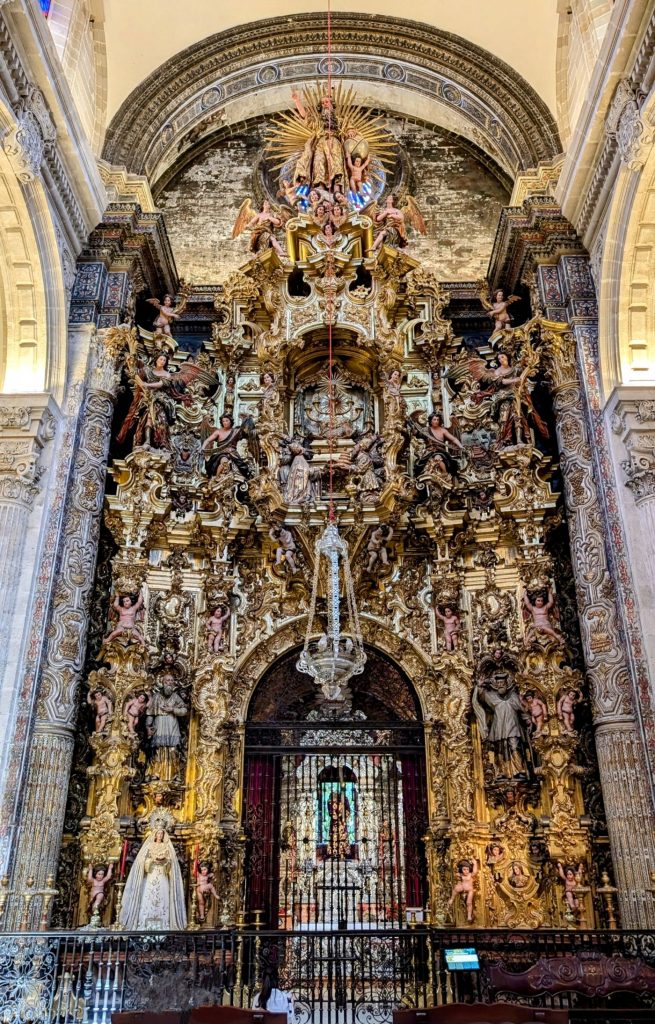
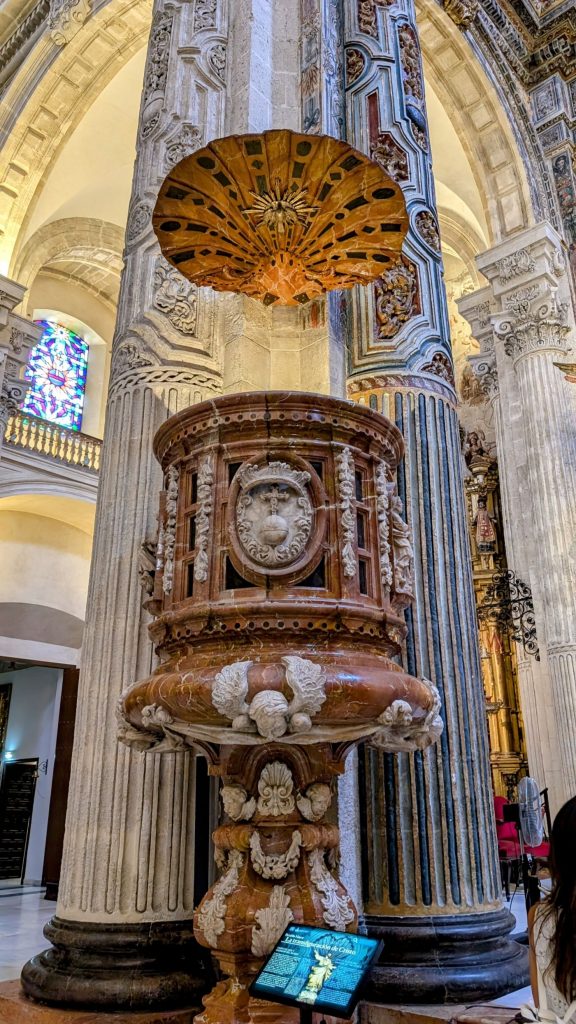

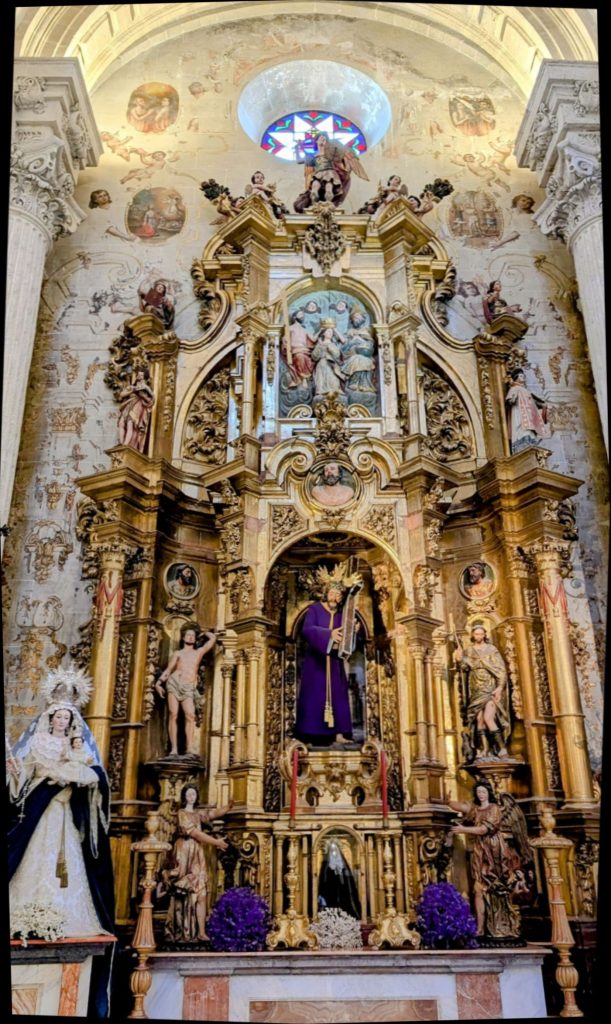


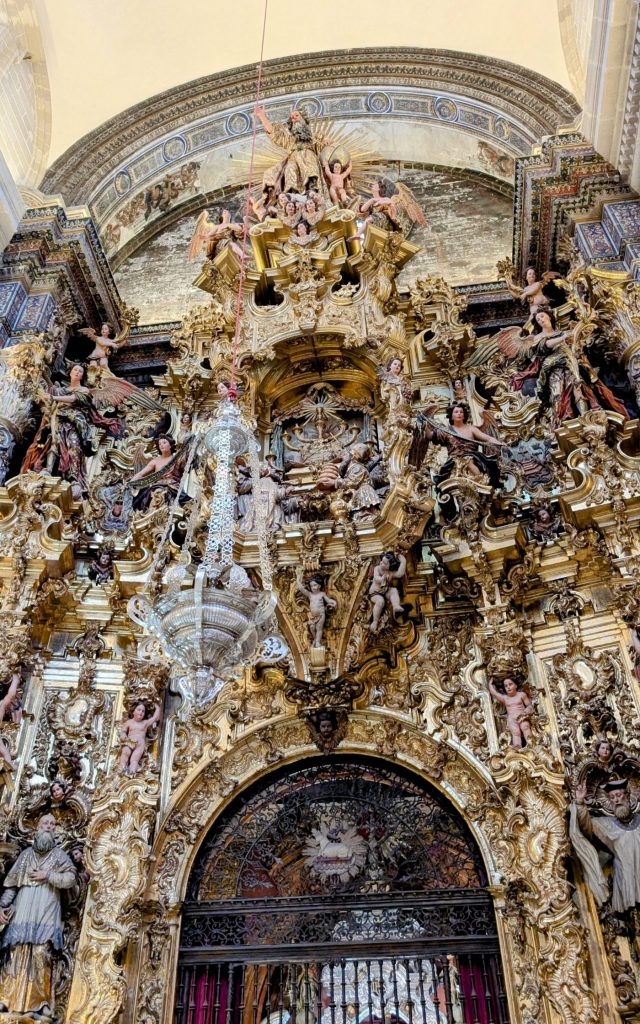
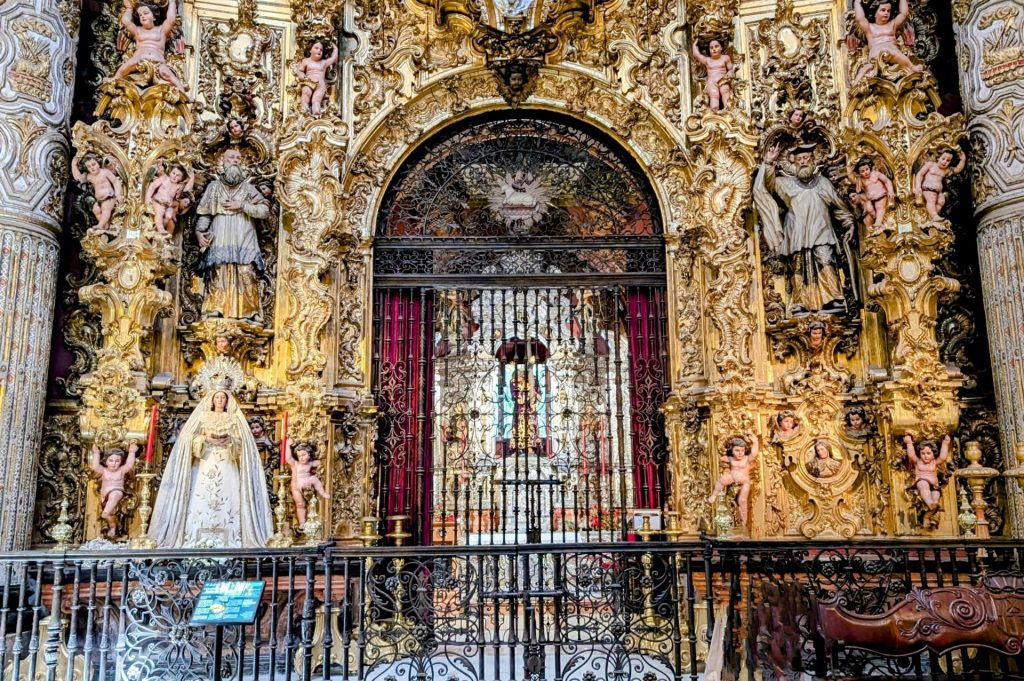
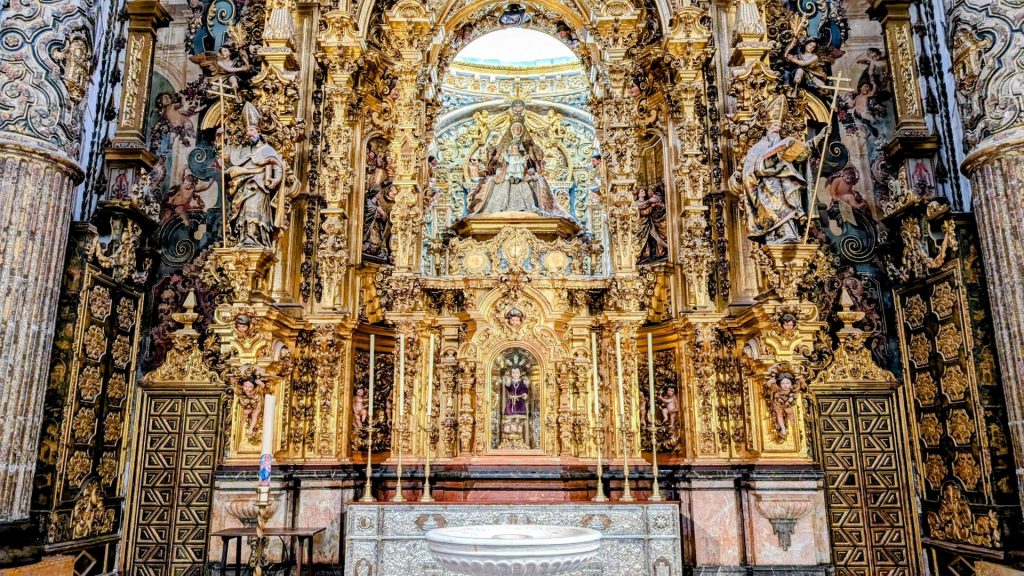
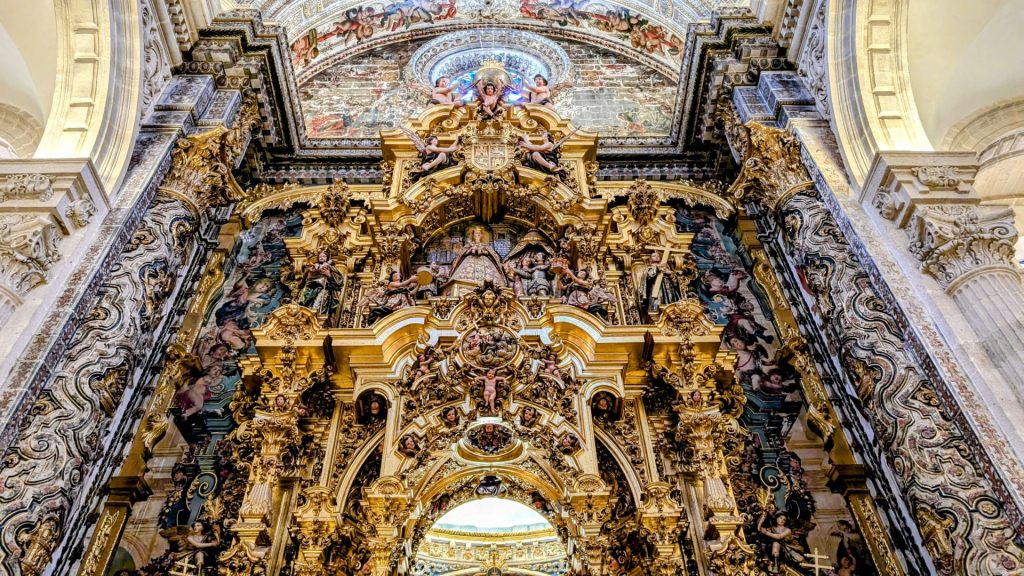
We will end today’s long post with a picture and story of the Carrier of Christ. This is in the same church. This powerful sculpture (below) of Saint Christopher is regarded as a wonder of polychrome wood sculpture, and remarkably is the first documented and preserved work of the fine sculptor, Juan Martinez Montañés, 1597. It is 225 cm high. It is said that it evokes the forms of the great Michelangelo.
The body pivots to the viewer while Saint Christopher turns to look at the Christ God, while the latter looks at us and blesses us with His right hand.
Saint Christopher was one of the most popular Catholic Christian heroes of the faith.

We will share the rest of our visit to Seville in the next post.
